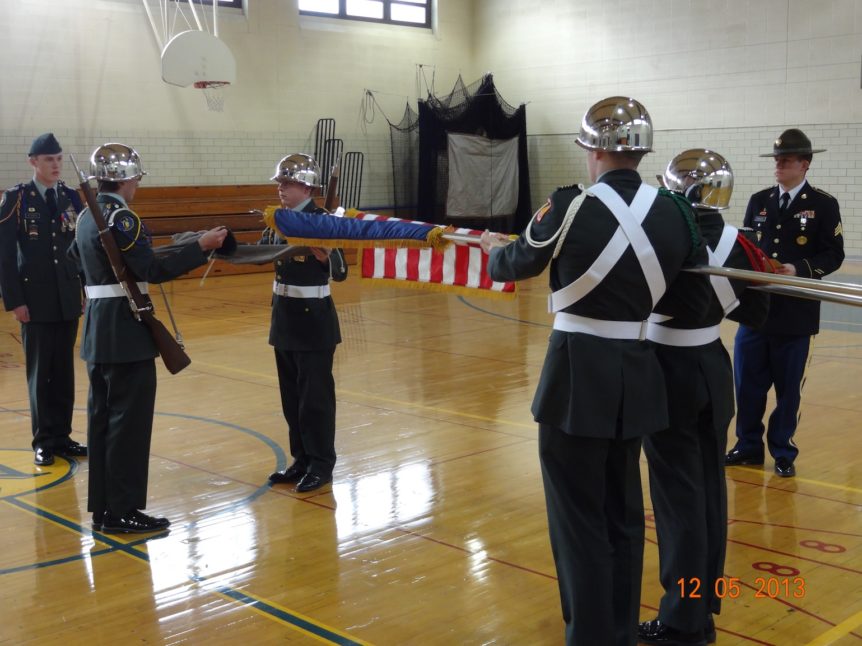
A Cased Flag
At right is a picture of a cased flag (this is a folded interment flag). Once the American flag is folded, it is considered cased and does not receive a salute.
Here is an example: the flag is brought down in the evening from a stationary flagpole. The team folds it, forms up and marches away (with one member holding the flag like the picture at right- point up or down does not matter) to store the flag in a specific room for the night. On the way back to the building, the team encounters cadets who stop and render a salute as the folded flag passes. While, saluting is not wrong, it is not necessary and communicates that you are unaware of published guidance regarding the flag.
A folded flag being carried to morning colors, or from evening colors, by a color detail is considered cased and not saluted.
MCO 5060.20
Point up or down?
When carrying the cased (folded) American flag, tradition for the military services dictates as follows: Army and Air Force, Marine Corps, are usually point up; Navy and Coast Guard, are usually point down, but these are not hard-and-fast rules, just tradition.

A Cased Color
Just as a cased flag does not receive a salute, a cased color does not render or receive a salute.
Almost every team in the JROTC community follows the example that is pictured here. Thank you to the MacArthur High School cadet who allowed me to use this picture and who was truly interested in this issue.
Why do teams dip the cased color? Because a salute from a color team involves dipping non-national colors and this is something that one would not really think twice about. None of the service drill and ceremonies manuals (you can find them all here) discuss this because it has never been and is never an issue for the military. It is JROTC drill meets that create issues like this.
When we bring cased flags and colors into a single discussion, we can then make logical decisions. Dipping a cased color is not proper because there’s nothing there to dip. Cased colors never receive a salute, so it follows that they would not render a salute, again, because the flag is “not there”. It’s like dipping a bare flagstaff- there is no reason to do so.
“Individuals or units passing or being passed by uncased Colors out of doors render honors.”
T.C. 3-21.5 (emphasis mine)
And Now the Dilemma of Cased Colors
Having said all that, consider this: Marine Corps, Navy, and Coast Guard color guards are mandated to practice/rehearse with the colors in cases. This is because the national (American flag), when uncased, receives honors, period. Practices and rehearsals would not go very well if they had to be run with complete formality. “Informal” training, meaning training that can stop immediately for corrections and resets, leads to formal performances.
This leads to the question of what does the departmental/organizational bearer do when dipping that color is required? He/she dips. The color bearer goes through all the motions as if the flag was not cased.
OK, so what about a JROTC color guard that must enter the drill pad with cased colors, report-in, and then continue with the colors sequence by uncasing the colors? Good question. My first answer is, don’t dip the staff for the reasons stated above. My second answer is that you can dip the staff so that the judge can check performance technique. However, that technique is displayed at least one more time in the sequence when the flags are uncased.
To my knowledge, no one has every provided guidance before. I have laid out my opinion here and that’s really all that I can do. My preference is not to dip the cased color because dipping does not make sense. If you choose to dip and I were judging, I would judge the technique and timing and then tell you why you might not want to do it anymore, but you would still receive a score.
The Furled Flag
Never carry or pose with a furled or partially furled flag. When the flag is removed from the case, it is immediately unfurled (unwrapped/unfolded from the staff). When a flag is furled (wrapped around the staff), it is immediately cased.
So now what?
Spread the word. Educate as many people as possible.
See also: How to Fold the Fringed American Flag


Comments 4
Sir,
R/R if you can be more specific in your reference
“From MCO P5060.20 (May 03)
A folded flag being carried to morning colors, or from evening colors, by a color detail is considered cased and not saluted.”
I am trying to provide this back up to my command, and am having difficulty supporting it, although I agree with the statment.
Thank you in advance
V/R
PO2 Edwards
Author
PO2 Edwads,
Thank you very much for the question and helping me solidify a point. I added the required information to the article: From MCO P5060.20 Ch 1, p. 7-12, para. 2d (May 03).
Thank you for your service, Go Navy!
I am also working to codify a flag requirement. In particular, the Old Glory Flag presentation at retirements. From the CG Honor Guard detail, I was told that the pointy end always faces down as opposed to up in your picture on the website. http://drillmaster.wpengine.com/2014/10/07/the-case-for-cased-flags-and-colors/ Where is it written about ‘cased flags’, passing the flag for one member to another with the pointy end, passing the fag for the final time with the blunt end versus the pointy end?
Author
Sir,
I redacted your personal information and will contact you shortly. Thank you for the question.